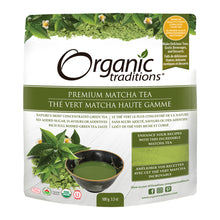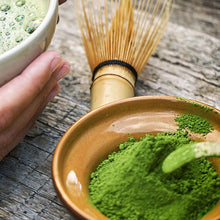Info: 100 g (3.5 oz) Resealable Bag of Certified Organic Premium Matcha Tea Powder
Matcha Tea is a super fine green tea powder, famous for its use in Japanese and Buddhist tea ceremonies. Matcha has a unique nutritional advantage – matcha powder consists of the entire tea leaf which provides up to 85% higher nutritional value compared to green tea infusions.
Info: 100 g (3.5 oz) Resealable Bag of Certified Organic Premium Matcha Tea Powder
Matcha Tea is a super fine green tea powder, famous for its use in Japanese and Buddhist tea ceremonies. Matcha has a unique nutritional advantage – matcha powder consists of the entire tea leaf which provides up to 85% higher nutritional value compared to green tea infusions.
Product Notes:
Japanese Matcha is likely the most highly revered type of green tea in the world, with a long history of ceremonial, medicinal, and daily diet uses.
The second most commonly consumed beverage in the world (next to water), teas are made by infusing boiled water and either herbs or varieties of the Camellia sinensis plant (related to the evergreen shrub and known as green, white, or black teas). Tea can bring a variety of health benefits, clinical studies indicate that green teas may help decrease the risk of various forms of cancer, heart disease, and other health conditions.
Well known as the premier form of green tea, matcha is a variety of the Camellia sinensis plant from which all green tea is derived, called gyokuro. Matcha tea leaves are picked young, usually in May. The stems and veins are removed (which can make the tea bitter), the leaves are lightly steamed to prevent fermentation, and stone ground to a consistency of talcum powder, resulting in a beautiful green coloured tea powder.
The combination of special processing, combined with consuming the entire plant, results in a beverage that is much higher in polyphenols, vitamins, minerals and catechins (like EGCG, the most important antioxidant for which green tea is known) than green or white tea infusions or traditional fermented teas, including black teas like oolong, because you consume the entire tea plant.
Not only is matcha rich in antioxidants (particularly this variety: one serving's equivalent to drinking 10 cups of regular green tea), but it's also a very good natural source of L-Theanine, an amino acid which somewhat paradoxically can not only provide balanced, sustained energy but also encourage a calm, relaxed, alert mind, making it a great alternative to coffee.
Making Tea
The practice of pouring just boiled water over dried herbs or tea leaves is called an "infusion," where just boiled water is used to extract healthful components from dried plant materials. The time the boiled water is in contact with the herbs or tea is often also called "steeping," After the steeping period, usually anywhere from 3-15 minutes, and longer with certain medicinal herbal tea concoctions (C-Blend, etc.) the herbs are discarded, and the liquid drunk. In a true infusion, the plant material (herbs, tea leaves, etc.) is not consumed.
While the majority of teas use the infusion method, the most healthful green tea of all consists of a specially processed green tea called matcha. What is unique about drinking matcha green tea, is that the tea leaves are NOT discarded after infusion, but consumed completely, which increases the level of nutrients, including antioxidants, vitamins, minerals and polyphenols by up to 85%, as compared to green tea infusions, where the tea leaves are discarded.
Unlike lesser grades of matcha which use hot pressure processing (which destroys delicate compounds and creates oxidation), or which include stems (creating a more bitter taste and a yellower colour), or whose leaves are picked later in the season when they're larger but with a lower concentration of beneficial nutrients, this organic premium matcha comes only from Tencha leaves collected in the critical interval after the spring harvest, offering a full-bodied earthy green tea taste without the astringency or bitterness associated with late harvest matchas. It's ready and easy to use, and comes in protective packaging for optimal nutrient and antioxidant integrity and stability.
Ingredients:
Certified organic matcha tea powder. Product of Japan.
Certified Organic, Gluten-Free, Vegan, Non-GMO, Kosher, Raw.
Eco-Cert * Canada Organic * USDA Organic
No added flavours, fillers, preservatives, additives, sugar/sweeteners, carriers, stabilizers or excipients.
ORAC value of 4,000 per 1 teaspoon, 3 gram serving (an ORAC value is a measurement of the antioxidant capacity of different foods).
Suggested Usage:
How to Prepare Matcha
To make matcha, the microfine powder is either whisked or blended into hot water or other liquids. You can increase the absorption of polyphenols, vitamins, minerals and antioxidants in all green teas (not just matcha) by adding lemon or lime juice. Matcha tea lovers often use a unique bamboo whisk, made of a single piece of bamboo, and a special ceremonial matcha tea bowl, where the water and matcha tea are whisked together.
First whisk between 1/2 to 1 teaspoon of Matcha in a small amount of warm water to make a smooth paste, then add more water (4-6 oz) and one tsp of Yacon Syrup.
Matcha powder can also be added as is to other ingredients to make elixirs or smoothies, or be sprinkled onto raw desserts, or be included as an ingredient in other recipes.
Add Matcha to super green food powders, shakes, soups, porridge, punches, ice creams, jellies and jams. You can also mix it with flour to make bread, cookies, and much more.
A favourite at many Japanese restaurants and upscale coffee houses is soymilk matcha, where matcha tea is whipped or blended into soymilk that has been slightly sweetened. High quality blenders like are perfect for whipping matcha into a wonderful frothy drink. Whipped with steamed soy, rice, or other veggie milks, you can make a matcha latte.
Matcha green tea is also used to improve the nutritional qualities of baked goods, cereals, energy/protein bars, and to colour and flavour the green ice cream sold in Japanese restaurants and sushi bars.
Refrigeration not required. Store in a cool, dry, dark place.
Warnings:
Allergen Information: Produced in a facility that packages tree nuts (Almonds, Hazelnuts and Cashews). The facility is dairy-free, gluten-free, soy-free and peanut free.




